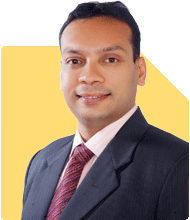Ramalingam Kalirajan |5367 Answers |Ask -Follow
Mutual Funds, Financial Planning Expert - Answered on May 26, 2024
He has an MBA in finance from the University of Madras and is a certified financial planner.
He is the director and chief financial planner at Holistic Investment, a Chennai-based firm that offers financial planning and wealth management advice.... more

Hi sir, Now I am 24 and I need a fix monthly income of 3+ lakhs by the age of 50 yrs. How much did I need to invest on monthly basis?
Understanding Your Financial Goal
To generate a fixed monthly income of Rs 3 lakhs, you need a substantial retirement corpus. The exact amount will depend on the assumed rate of return and inflation. Generally, a well-planned investment strategy can help achieve this target.
Importance of Starting Early
Starting your investments early is beneficial. Compounding plays a crucial role in wealth accumulation. The longer your money is invested, the more it grows, making it easier to achieve your financial goals.
Estimating the Required Corpus
A fixed monthly income of Rs 3 lakhs translates to Rs 36 lakhs annually. Assuming a conservative withdrawal rate of 4%, you would need a retirement corpus of approximately Rs 9 crores. This corpus can sustain withdrawals while preserving capital.
Monthly Investment Requirement
To reach a corpus of Rs 9 crores in 26 years, regular and disciplined investments are essential. Based on historical returns of diversified equity mutual funds, you can estimate the required monthly investment. Assuming an annual return of around 12%, you need to invest a significant amount monthly.
Choosing the Right Investment Avenues
Diversification is key to managing risk and achieving stable returns. Here are some recommended investment options:
Equity Mutual Funds: These funds offer high returns over the long term. Diversify across large-cap, mid-cap, and small-cap funds to balance risk and return.
Hybrid Funds: These funds invest in both equity and debt. They provide stability and moderate returns, making them suitable for long-term goals.
Debt Funds: While offering lower returns, debt funds provide stability. They should form a smaller portion of your portfolio to reduce overall risk.
The Benefits of SIPs
Systematic Investment Plans (SIPs) are an effective way to invest regularly. SIPs help in rupee cost averaging and reduce the impact of market volatility. Investing a fixed amount monthly ensures disciplined savings and wealth accumulation.
The Role of Actively Managed Funds
Actively managed funds are preferable over index funds for long-term goals. Fund managers actively select securities to outperform the market. This active management can potentially provide higher returns, aiding in faster accumulation of the required corpus.
Disadvantages of Direct Funds
Direct funds require self-management and in-depth market knowledge. Without professional guidance, it can be challenging to make informed investment decisions. Investing through regular funds with the assistance of a Mutual Fund Distributor (MFD) and a Certified Financial Planner (CFP) offers professional advice and personalized strategies.
Regular Review and Rebalancing
Regularly review your investment portfolio to track performance. Rebalance your portfolio periodically to maintain the desired asset allocation. This involves shifting investments from overperforming to underperforming assets to stay aligned with your financial goals.
Professional Guidance
Engage with a Certified Financial Planner (CFP) for personalized advice. A CFP can help in selecting the right funds, managing risks, and ensuring that your investment strategy aligns with your long-term financial goals.
Inflation and Its Impact
Inflation erodes purchasing power over time. Your investment strategy should aim for returns that outpace inflation. Equity investments generally offer inflation-beating returns, making them essential for long-term wealth creation.
The Importance of Financial Discipline
Consistency is crucial in achieving financial goals. Stay committed to your investment plan, even during market downturns. Financial discipline ensures steady progress towards your target corpus.
Building a Contingency Fund
Maintain a contingency fund to handle unexpected expenses. This ensures that your primary investments remain intact, and you don’t have to liquidate assets prematurely.
Tax Planning
Consider the tax implications of your investments. Opt for tax-efficient investment options to maximize returns. Long-term capital gains from equity funds are tax-advantaged, making them a suitable choice for long-term goals.
Conclusion
Achieving a fixed monthly income of Rs 3 lakhs by the age of 50 is attainable with disciplined investing and strategic planning. Start early, diversify your investments, and seek professional guidance. Regular review and rebalancing of your portfolio will ensure you stay on track and maximize your returns.
Best Regards,
K. Ramalingam, MBA, CFP,
Chief Financial Planner,
www.holisticinvestment.in
You may like to see similar questions and answers below
Sunil Lala |193 Answers |Ask -Follow
Financial Planner - Answered on Oct 13, 2023
Sanjeev Govila |458 Answers |Ask -Follow
Financial Planner - Answered on Nov 15, 2023
Ramalingam Kalirajan |5367 Answers |Ask -Follow
Mutual Funds, Financial Planning Expert - Answered on May 29, 2024
Ramalingam Kalirajan |5367 Answers |Ask -Follow
Mutual Funds, Financial Planning Expert - Answered on Apr 23, 2024
Dr Nagarajan J S K |58 Answers |Ask -Follow
Health Science and Pharmaceutical Careers Expert - Answered on Jul 27, 2024
Dr Nagarajan J S K |58 Answers |Ask -Follow
Health Science and Pharmaceutical Careers Expert - Answered on Jul 27, 2024
Dr Nagarajan J S K |58 Answers |Ask -Follow
Health Science and Pharmaceutical Careers Expert - Answered on Jul 26, 2024
Krishna Kumar |358 Answers |Ask -Follow
Workplace Expert - Answered on Jul 26, 2024
Krishna Kumar |358 Answers |Ask -Follow
Workplace Expert - Answered on Jul 26, 2024
Krishna Kumar |358 Answers |Ask -Follow
Workplace Expert - Answered on Jul 26, 2024
Krishna Kumar |358 Answers |Ask -Follow
Workplace Expert - Answered on Jul 26, 2024
Krishna Kumar |358 Answers |Ask -Follow
Workplace Expert - Answered on Jul 26, 2024
Krishna Kumar |358 Answers |Ask -Follow
Workplace Expert - Answered on Jul 26, 2024
Krishna Kumar |358 Answers |Ask -Follow
Workplace Expert - Answered on Jul 26, 2024





















